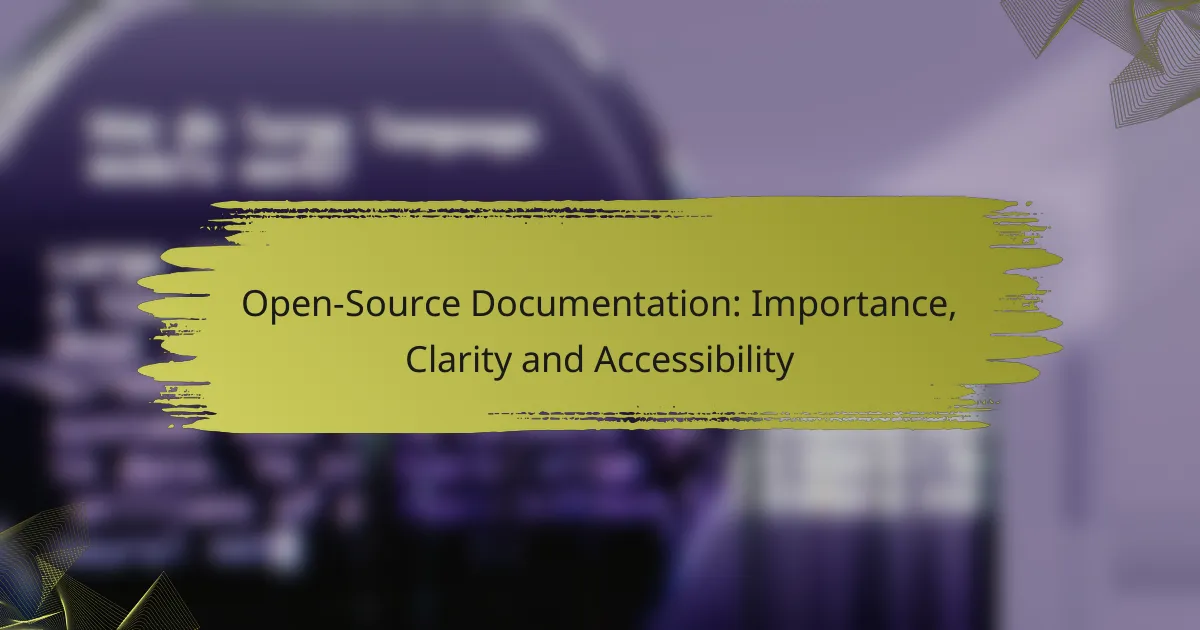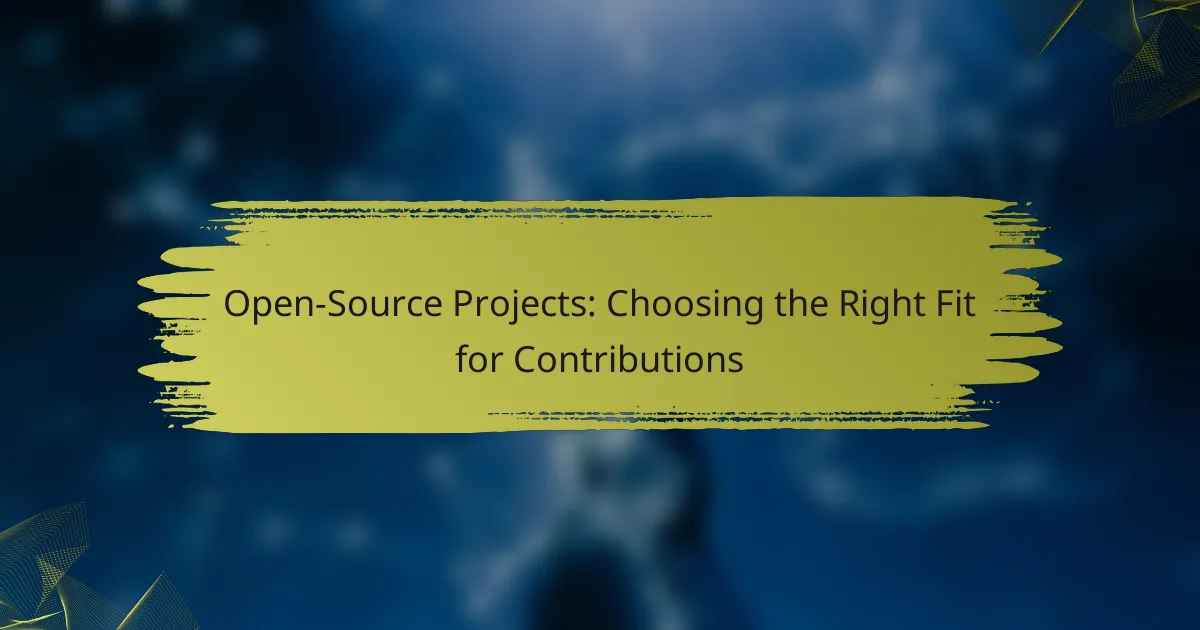Open-source documentation plays a vital role in software development by providing essential guidelines that enhance understanding and usability. Clear and accessible documentation not only improves user experience but also fosters collaboration and community engagement, allowing both developers and users to effectively navigate and contribute to projects.
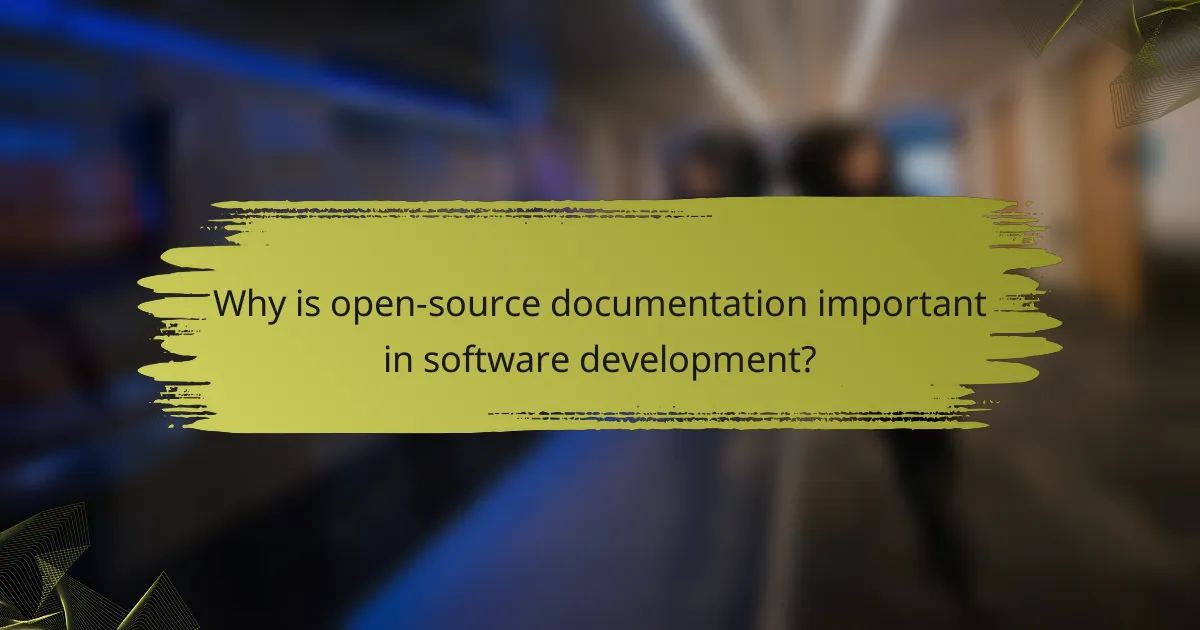
Why is open-source documentation important in software development?
Open-source documentation is crucial in software development as it provides clear guidelines and information that facilitate understanding and usage of the software. Well-structured documentation enhances collaboration, improves usability, and fosters community engagement, making it easier for developers and users alike to navigate and contribute to projects.
Enhances collaboration among developers
Open-source documentation serves as a common reference point for developers working on the same project. It allows team members to understand the codebase, adhere to coding standards, and follow best practices, which streamlines the development process.
When documentation is clear and accessible, it reduces the learning curve for new contributors, enabling them to quickly get up to speed and start contributing. This collaborative environment can lead to faster project advancements and innovation.
Improves software usability for end-users
Comprehensive documentation helps end-users understand how to effectively use the software. It typically includes installation guides, user manuals, and troubleshooting tips that empower users to maximize the software’s potential.
When users can easily find answers to their questions or learn how to perform tasks, they are more likely to have a positive experience, which can lead to increased adoption and satisfaction with the software.
Facilitates knowledge sharing and community growth
Open-source documentation encourages knowledge sharing by providing a platform where developers can contribute their insights and experiences. This collaborative knowledge base can evolve over time, benefiting both current and future users.
A thriving community around well-documented projects often leads to more frequent updates, feature enhancements, and a supportive network for troubleshooting. Engaging with the community through forums or contribution guidelines can further strengthen these connections.

How does clarity in open-source documentation impact user experience?
Clarity in open-source documentation significantly enhances user experience by making information easily understandable and accessible. When documentation is clear, users can quickly grasp concepts, troubleshoot issues, and effectively utilize the software.
Reduces learning curve for new users
Clear documentation simplifies the onboarding process for new users by breaking down complex concepts into digestible parts. This can include step-by-step guides, visual aids, and clear definitions of terms. For instance, a well-structured tutorial can reduce the time it takes for a user to become proficient from weeks to just a few days.
To further aid understanding, consider using examples that relate to common use cases. This approach helps users connect theoretical knowledge with practical application, making the learning process smoother and more intuitive.
Increases user satisfaction and retention
When users find documentation easy to navigate and understand, their overall satisfaction with the software increases. Satisfied users are more likely to continue using the software and contribute to the community, creating a positive feedback loop. For example, clear FAQs and troubleshooting sections can prevent frustration and enhance user loyalty.
To maintain high satisfaction levels, regularly update documentation to reflect changes in the software and incorporate user feedback. This ensures that the information remains relevant and useful, fostering a strong user community and encouraging long-term engagement.
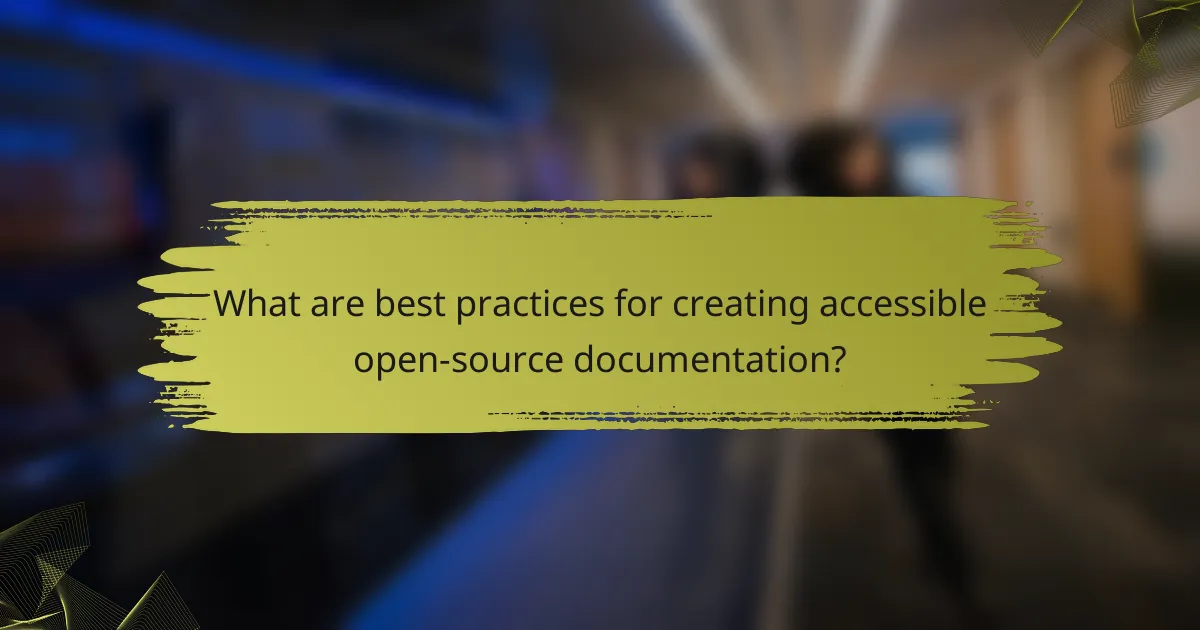
What are best practices for creating accessible open-source documentation?
Creating accessible open-source documentation involves using clear language, structured formats, and visual aids to ensure that all users can understand and utilize the content effectively. Prioritizing accessibility not only enhances user experience but also broadens the reach of the documentation.
Use clear language and structure
Clear language and a well-organized structure are essential for effective documentation. Use simple, straightforward vocabulary and avoid jargon unless necessary, providing definitions when you do. Break down complex information into smaller, digestible sections to aid comprehension.
Utilize headings, bullet points, and numbered lists to create a logical flow. This helps users navigate the content easily and find the information they need quickly. For example, a table of contents at the beginning can guide users through the document.
Incorporate visual aids and examples
Visual aids such as diagrams, screenshots, and videos can significantly enhance understanding. They provide context and illustrate concepts that might be difficult to grasp through text alone. For instance, a flowchart can clarify a process that is explained in writing.
Including real-world examples or case studies can also make the documentation more relatable. When users see practical applications of the information, they are more likely to engage with the content. Aim to use visuals that are clear and relevant, ensuring they are properly labeled for accessibility.

Which tools can enhance open-source documentation accessibility?
Several tools can significantly improve the accessibility of open-source documentation by simplifying the writing process and enhancing user experience. Utilizing the right tools can make documentation clearer, more organized, and easier for users to navigate.
Markdown editors like Typora
Markdown editors, such as Typora, provide a user-friendly interface for writing and formatting documentation. They allow authors to focus on content without getting bogged down by complex formatting options, which can lead to clearer and more concise documentation.
With Typora, users can see the final output in real-time, making it easier to ensure that the documentation is visually appealing and accessible. This tool supports various export formats, enabling easy sharing and integration with other platforms.
Documentation generators like Docusaurus
Documentation generators like Docusaurus streamline the process of creating and maintaining documentation websites. They automatically convert Markdown files into a structured website, which can enhance accessibility through better navigation and search functionality.
Docusaurus also supports versioning, allowing users to access different documentation versions easily. This is particularly useful for open-source projects that evolve over time, ensuring that users always have access to the most relevant information.

What criteria should be considered when evaluating open-source documentation?
When evaluating open-source documentation, consider factors such as content accuracy, relevance, ease of navigation, and searchability. These criteria ensure that users can effectively understand and utilize the software.
Content accuracy and relevance
Content accuracy and relevance are critical for effective open-source documentation. Ensure that the information is up-to-date and reflects the current version of the software. Outdated or incorrect details can lead to confusion and hinder user adoption.
To assess accuracy, cross-reference documentation with the actual software functionality. Look for community feedback or contributions that highlight discrepancies, as these can indicate areas needing improvement.
Ease of navigation and searchability
Ease of navigation and searchability significantly enhance the user experience in open-source documentation. A well-structured layout with clear headings, subheadings, and a logical flow allows users to find information quickly. Implementing a search feature can further streamline access to specific topics.
Consider using a table of contents and internal links to guide users through the documentation. Additionally, ensure that search functionality returns relevant results, as this can drastically reduce the time users spend looking for information.
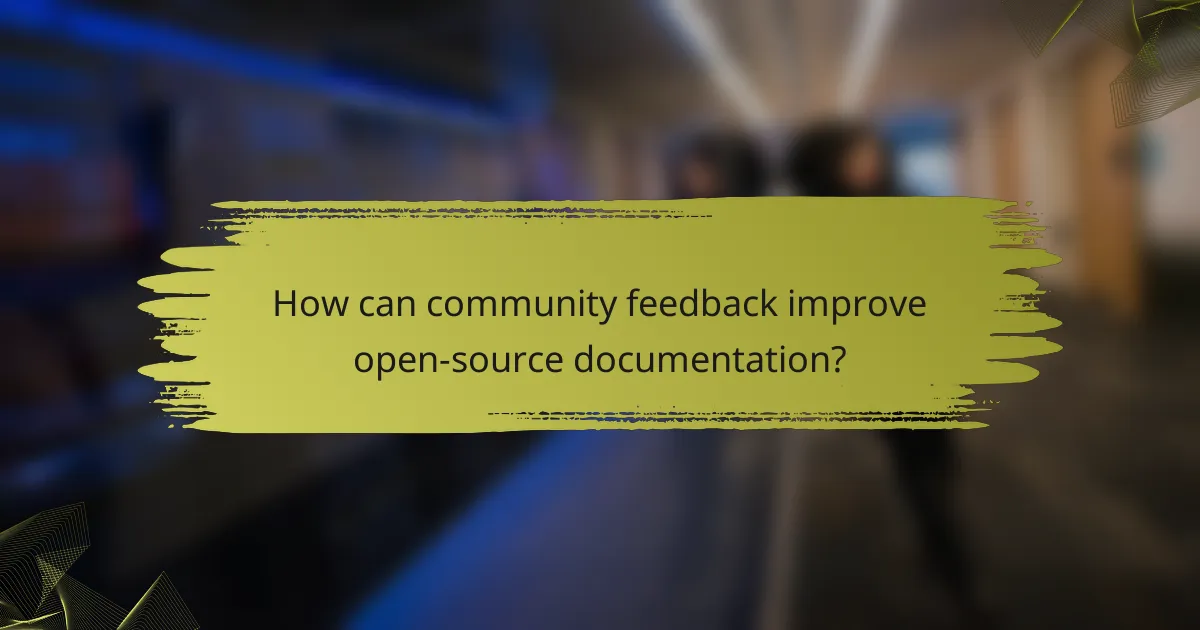
How can community feedback improve open-source documentation?
Community feedback is essential for enhancing open-source documentation by providing insights from diverse users. This input helps identify strengths and weaknesses, leading to clearer and more effective documentation.
Encourages continuous improvement
Community feedback fosters a culture of ongoing enhancement in open-source documentation. When users share their experiences and suggestions, it creates opportunities for authors to refine content, update outdated information, and improve usability. Regular updates based on user input can significantly elevate the quality of documentation over time.
For instance, a project might implement a feedback loop where users can rate documentation sections or suggest edits. This practice not only engages the community but also ensures that the documentation evolves alongside the software.
Identifies gaps and areas for enhancement
Community feedback plays a crucial role in pinpointing gaps in open-source documentation. Users often encounter challenges that the original authors may overlook, such as unclear instructions or missing information. By voicing these concerns, the community helps highlight specific areas that require attention.
To effectively identify these gaps, projects can encourage users to submit issues or create discussion threads focused on documentation. This collaborative approach allows for a comprehensive understanding of user needs and leads to targeted improvements.
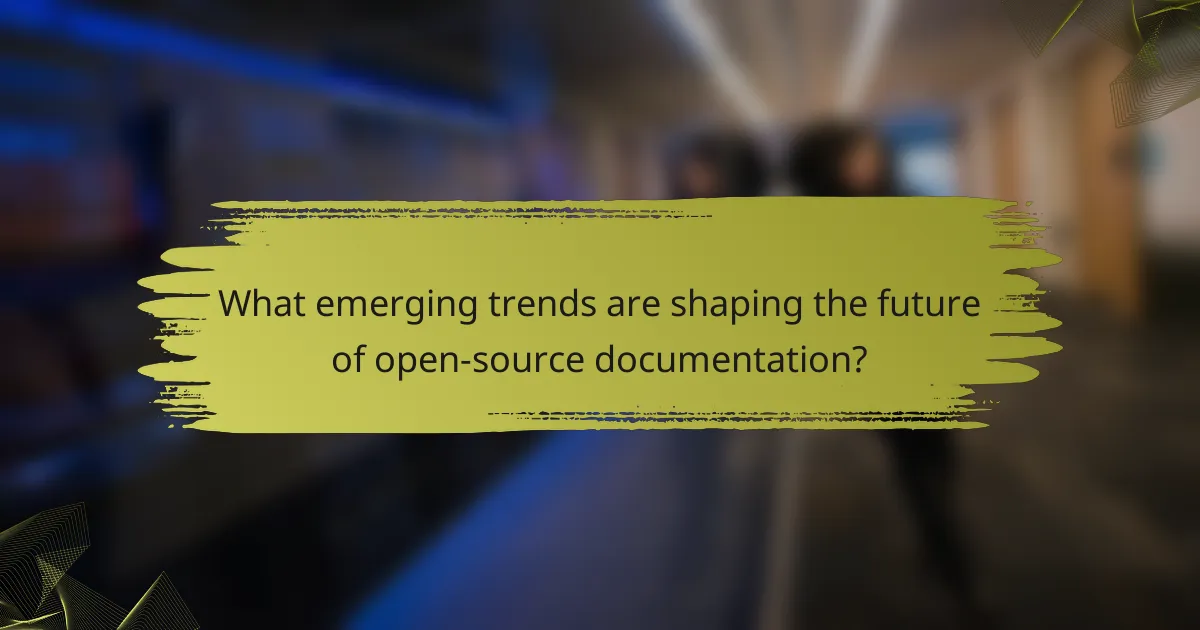
What emerging trends are shaping the future of open-source documentation?
Emerging trends in open-source documentation are increasingly focused on collaboration, user-centric design, and automation. These trends aim to enhance clarity and accessibility, making documentation more effective for diverse audiences.
Increased Collaboration Among Contributors
Collaboration is becoming essential in open-source documentation as more contributors from various backgrounds engage in projects. This trend encourages diverse perspectives, leading to richer content and improved accuracy. Tools like GitHub facilitate real-time collaboration, allowing contributors to suggest edits and updates seamlessly.
To foster effective collaboration, projects should establish clear guidelines for contributions. This includes defining roles, setting expectations for quality, and utilizing version control to track changes. Regular meetings or discussions can also help align contributors and maintain focus on project goals.
User-Centric Design Principles
User-centric design principles are gaining traction in open-source documentation to ensure content is accessible and easy to navigate. This approach emphasizes understanding the needs of users, which can vary widely based on their technical expertise and use cases. Incorporating feedback from users can lead to more intuitive documentation structures.
Implementing user-centric design involves creating clear navigation paths, using consistent terminology, and providing examples that resonate with the audience. Tools like user testing and surveys can help gather insights on how to improve documentation effectively.
Automation and AI Integration
Automation and AI are transforming how open-source documentation is created and maintained. Automated tools can generate documentation from code comments, ensuring that updates are consistently reflected in the documentation. This reduces the burden on contributors and increases the accuracy of the content.
Integrating AI can also enhance the searchability of documentation, making it easier for users to find relevant information quickly. However, it’s crucial to balance automation with human oversight to maintain quality and clarity in the documentation.
